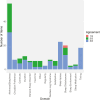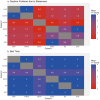Pioneering a multi-phase framework to harmonize self-reported sleep data across cohorts
- PMID: 38752786
- PMCID: PMC11381567
- DOI: 10.1093/sleep/zsae115
Pioneering a multi-phase framework to harmonize self-reported sleep data across cohorts
Abstract
Study objectives: Harmonizing and aggregating data across studies enables pooled analyses that support external validation and enhance replicability and generalizability. However, the multidimensional nature of sleep poses challenges for data harmonization and aggregation. Here we describe and implement our process for harmonizing self-reported sleep data.
Methods: We established a multi-phase framework to harmonize self-reported sleep data: (1) compile items, (2) group items into domains, (3) harmonize items, and (4) evaluate harmonizability. We applied this process to produce a pooled multi-cohort sample of five US cohorts plus a separate yet fully harmonized sample from Rotterdam, Netherlands. Sleep and sociodemographic data are described and compared to demonstrate the utility of harmonization and aggregation.
Results: We collected 190 unique self-reported sleep items and grouped them into 15 conceptual domains. Using these domains as guiderails, we developed 14 harmonized items measuring aspects of satisfaction, alertness/sleepiness, timing, efficiency, duration, insomnia, and sleep apnea. External raters determined that 13 of these 14 items had moderate-to-high harmonizability. Alertness/Sleepiness items had lower harmonizability, while continuous, quantitative items (e.g. timing, total sleep time, and efficiency) had higher harmonizability. Descriptive statistics identified features that are more consistent (e.g. wake-up time and duration) and more heterogeneous (e.g. time in bed and bedtime) across samples.
Conclusions: Our process can guide researchers and cohort stewards toward effective sleep harmonization and provide a foundation for further methodological development in this expanding field. Broader national and international initiatives promoting common data elements across cohorts are needed to enhance future harmonization and aggregation efforts.
Keywords: data harmonization; data sharing; data standardization; sleep disorder; sleep health; sleepiness.
© The Author(s) 2024. Published by Oxford University Press on behalf of Sleep Research Society. All rights reserved. For commercial re-use, please contact reprints@oup.com for reprints and translation rights for reprints. All other permissions can be obtained through our RightsLink service via the Permissions link on the article page on our site—for further information please contact journals.permissions@oup.com.
Figures





Comment in
-
Why harmonizing cohorts in sleep is a good idea and the labor of doing so?Sleep. 2024 Sep 9;47(9):zsae129. doi: 10.1093/sleep/zsae129. Sleep. 2024. PMID: 38872490 Free PMC article. No abstract available.
Similar articles
-
A composite measure of sleep health is associated with symptoms of depression among Japanese female hospital nurses.Compr Psychiatry. 2020 Feb;97:152151. doi: 10.1016/j.comppsych.2019.152151. Epub 2019 Dec 5. Compr Psychiatry. 2020. PMID: 31954287
-
Racial/Ethnic Differences in Sleep Disturbances: The Multi-Ethnic Study of Atherosclerosis (MESA).Sleep. 2015 Jun 1;38(6):877-88. doi: 10.5665/sleep.4732. Sleep. 2015. PMID: 25409106 Free PMC article.
-
Insomnia Disorder Among Older Veterans: Results of a Postal Survey.J Clin Sleep Med. 2019 Apr 15;15(4):543-551. doi: 10.5664/jcsm.7710. J Clin Sleep Med. 2019. PMID: 30952212 Free PMC article.
-
[Sleepiness among adolescents: etiology and multiple consequences].Encephale. 2023 Feb;49(1):87-93. doi: 10.1016/j.encep.2022.05.004. Epub 2022 Aug 12. Encephale. 2023. PMID: 35970642 Review. French.
-
Sleep characteristics across the lifespan in 1.1 million people from the Netherlands, United Kingdom and United States: a systematic review and meta-analysis.Nat Hum Behav. 2021 Jan;5(1):113-122. doi: 10.1038/s41562-020-00965-x. Epub 2020 Nov 16. Nat Hum Behav. 2021. PMID: 33199855
Cited by
-
Why harmonizing cohorts in sleep is a good idea and the labor of doing so?Sleep. 2024 Sep 9;47(9):zsae129. doi: 10.1093/sleep/zsae129. Sleep. 2024. PMID: 38872490 Free PMC article. No abstract available.
-
An international multi-cohort investigation of self-reported sleep and future depressive symptoms in older adults.Sci Rep. 2025 Jul 4;15(1):23918. doi: 10.1038/s41598-025-07864-z. Sci Rep. 2025. PMID: 40615433 Free PMC article.
-
Sleep health profiles across six population-based cohorts and recommendations for validating clustering models.Sleep Health. 2025 Jun;11(3):371-381. doi: 10.1016/j.sleh.2025.01.012. Epub 2025 Mar 21. Sleep Health. 2025. PMID: 40118730
References
-
- Wasserstein RL, Lazar NA.. The ASA’s statement on p-values: context, process, and purpose. Am Stat. 2016;70(2):129–133. doi: 10.1080/00031305.2016.1154108 - DOI
Publication types
MeSH terms
Grants and funding
- R01 AG022018/AG/NIA NIH HHS/United States
- RF1 AG056331/AG/NIA NIH HHS/United States
- RF1AG056331/NH/NIH HHS/United States
- R01 AG017917/AG/NIA NIH HHS/United States
- U01 AG027810/AG/NIA NIH HHS/United States
- U01 AG042124/AG/NIA NIH HHS/United States
- U01 AG042139/AG/NIA NIH HHS/United States
- U01 AG042140/AG/NIA NIH HHS/United States
- U01 AG042143/AG/NIA NIH HHS/United States
- U01 AG042145/AG/NIA NIH HHS/United States
- U01 AG042168/AG/NIA NIH HHS/United States
- U01 AR066160/AR/NIAMS NIH HHS/United States
- R01 AG066710/AG/NIA NIH HHS/United States
- UL1 TR002369/TR/NCATS NIH HHS/United States
- R01 HL071194/HL/NHLBI NIH HHS/United States
- R01 HL070848/HL/NHLBI NIH HHS/United States
- R01 HL070847/HL/NHLBI NIH HHS/United States
- R01 HL070842/HL/NHLBI NIH HHS/United States
- R01 HL070841/HL/NHLBI NIH HHS/United States
- R01 HL070837/HL/NHLBI NIH HHS/United States
- R01 HL070838/HL/NHLBI NIH HHS/United States
- R01 HL070839/HL/NHLBI NIH HHS/United States
- R01 AG005407/AG/NIA NIH HHS/United States
- R01 AR035582/AR/NIAMS NIH HHS/United States
- R01 AR035583/AR/NIAMS NIH HHS/United States
- R01 AR035584/AR/NIAMS NIH HHS/United States
- R01 AG005394/AG/NIA NIH HHS/United States
- R01 AG027574/AG/NIA NIH HHS/United States
- R01 AG027576/AG/NIA NIH HHS/United States
- R01 AG026720/AG/NIA NIH HHS/United States
- R01 HL098433/HL/NHLBI NIH HHS/United States
- UL1 TR000040/TR/NCATS NIH HHS/United States
- UL1 TR001079/TR/NCATS NIH HHS/United States
- UL1 TR001420/TR/NCATS NIH HHS/United States
- R35 HL135818/HL/NHLBI NIH HHS/United States
- R01 AG070867/AG/NIA NIH HHS/United States
LinkOut - more resources
Full Text Sources

